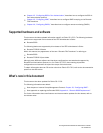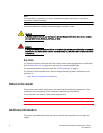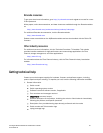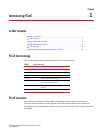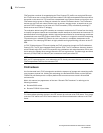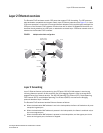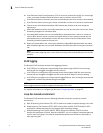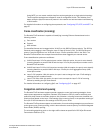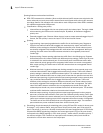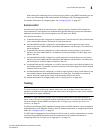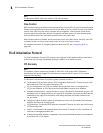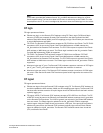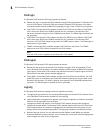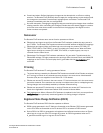
4 Converged Enhanced Ethernet Administrator’s Guide
53-1002163-02
Layer 2 Ethernet overview
1
DRAFT: BROCADE CONFIDENTIAL
• If the Ethernet Frame Check Sequence (FCS) is incorrect, because the switch is in cut-through
mode, a correctly formatted Ethernet frame is sent out with an incorrect FCS.
• If the Ethernet frame is too short, the frame is discarded and the error counter is incremented.
• If the Ethernet frame is too long, the frame is discarded and the error counter is incremented.
• Frames sent to a broadcast destination MAC address are flooded on all ports except the
ingress port.
• When MAC address entries in the lookup table time out, they are removed. In this event, frame
forwarding changes from unicast to flood.
• An existing MAC address entry in the lookup table is discarded when a device is moved to a
new location. When a device is moved, the ingress frame from the new port causes the old
lookup table entry to be discarded and the new entry inserted into the lookup table. Frame
forwarding remains unicast to the new port.
• When the lookup table is full, new entries replace the oldest MAC addresses after the oldest
MAC addresses age and time out. MAC addresses that still have traffic running are not timed
out.
NOTE
New entries start replacing older entries when the lookup table reaches 90 percent of its 32k
capacity.
VLAN tagging
The Brocade FCoE hardware handles VLAN tagging as follows:
• If the CEE port is configured to tag incoming frames with a single VLAN ID, then incoming
frames that are untagged are tagged with the VLAN ID.
• If the CEE port is configured to tag incoming frames with multiple VLAN IDs, then incoming
frames that are untagged are tagged with the correct VLAN ID based on the port setting.
• If the CEE port is configured to accept externally tagged frames, then incoming frames that are
tagged with a VLAN ID are passed through unchanged.
NOTE
Only a single switch-wide VLAN is capable of forwarding FCoE traffic.
For detailed information on configuring VLANs, see “Configuring VLANs” on page 45.
Loop-free network environment
The Brocade FCoE hardware uses the following protocols to maintain a loop-free network
environment:
• 802.1D Spanning Tree Protocol (STP)—STP is required to create a loop-free topology in the LAN.
• Rapid Spanning Tree Protocol (RSTP)—RSTP evolved from the 802.1D STP standard. RSTP
provides for a faster spanning tree convergence after a topology change.
• Multiple Spanning Tree Protocol (MSTP)—MSTP defines an extension to RSTP to further
develop the usefulness of VLANs. With per-VLAN MSTP, you can configure a separate spanning
tree for each VLAN group. The protocol automatically blocks the links that are redundant in
each spanning tree.



